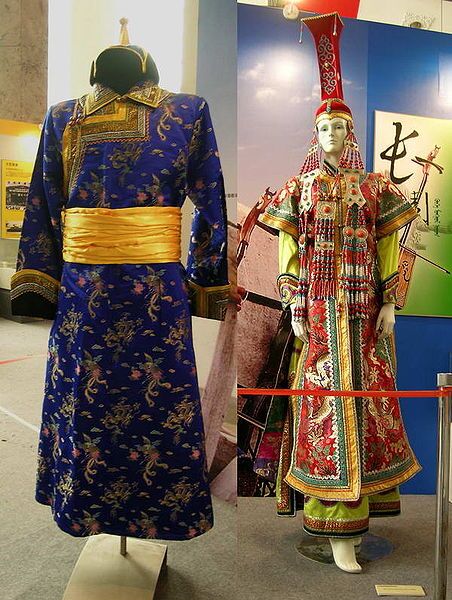The Central Asian climate and weather conditions determined Mongol dress, both traditionally and today. Men, women and children essentially wore the same type of clothing, differentiated by color, color combination, size and decoration to specify age, gender, married state and social status. Everyone wore the deel, a robe-like wrap that resembled a long overcoat that closed diagonally from the side to the front. The deel was worn with a meters-long sash wound around the waist. The basic deel was worn by all the tribes, but with many small differences in shape or color. To see these differences, check out this Web site on traditional Mongolian clothes.
Both sexes had winter and summer clothes. Winter demanded warm, snug garments to help keep in body heat. Summer clothes were made of lighter fabrics. Everything the Mongols wore were made for a rough, active life and allowed the wearer to move freely. Men, women and children wore trousers under the deel.
Mongols wore boots and hats outside and inside the gers. Hats were practical, to keep the head warm but were also highly decorated and colorful. Mongol boots called gutuls were made with horseback riding in mind.
The Deel
The deel is ancient but still worn today as it is an extremely practical, tough garment for a horseback nation. Men’s deels could be long or short, but usually went down to the thighs. Women’s deels were always long. Summer deels were made of cotton or silk while winter deels were made of felted wool, leather, suede lined with fur or sheepskin, with the warm wooly part turned inwards . The meters-long sash tied at the waist served as a girdle to protect against the rough shaking during speedy horse rides. Essential tools such as eating gear, tobacco and pipe, knives, cups and firestones were hung off the sash.
Hats
Mongols loved their headgear and had over 100 different types of hats. Each tribe had a distinctive type of headgear. One common hat was the loovuz, made of felted wool which served for daily wear. It had flaps that could be tied up or lowered to cover the ears. Winter time brought warm hats made of fur such as sable or silver fox. During festivals, Mongol men and women wore their fanciest hats and headgear, colorful and gaudy with decorations including fancy fabrics and jewels.
Footgear
Mongols all wore boots as the most practical foot gear. Boots were made of tough leather and were often worn with warm felt socks. Boots had turned up toes to allow the foot to easily slip out of stirrups should a rider fall, but also added a pocket of warmer air in the boot. The tough hide bootleg protected legs when riding or walking through tough grass. In winter, fur covers called degtii were pulled over boots. Boot heels could be high or low, depending on the boots’ purpose.
Additional Resources About The Mongols
Cite This Article
"Mongols: Clothes for a Rough, Active Life in the Cold" History on the Net© 2000-2024, Salem Media.
July 26, 2024 <https://www.historyonthenet.com/mongols-clothes-for-a-rough-active-life-in-the-cold>
More Citation Information.

